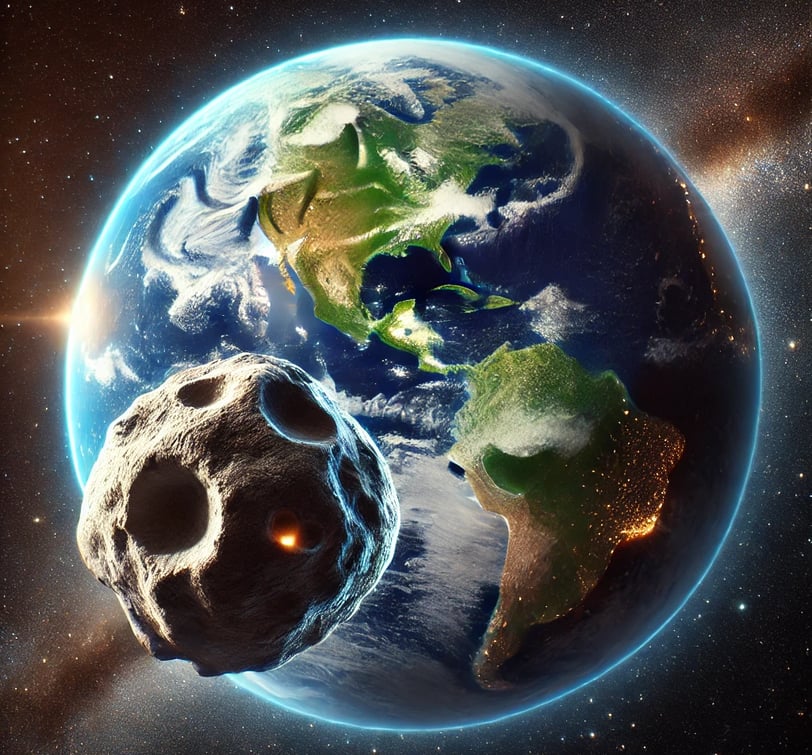Asteroid 2024 YR4: What Do We Know So Far?
Asteroids have always sparked both curiosity and concern. One of the latest to be closely monitored by astronomers is 2024 YR4, an object that has caught attention due to its trajectory. But does it pose any real risk to Earth? Let’s take a closer look.
2/13/20252 min read


What is Asteroid 2024 YR4?
2024 YR4 is a newly identified asteroid classified as a Near-Earth Object (NEO). This means its orbit brings it relatively close to our planet, requiring constant monitoring. Preliminary data estimates its diameter to be between 50 and 150 meters, placing it in the category of asteroids capable of causing significant damage if they were to enter Earth’s atmosphere.
Is There Any Real Danger?
Fortunately, current predictions indicate that 2024 YR4 does not pose an immediate threat. Scientists have calculated its orbit based on recent observations, and for the next few decades, it is expected to pass at a safe distance from Earth. However, gravitational interactions with other celestial bodies can slightly alter an asteroid’s path over time, so it will continue to be closely observed.
Other Asteroids with Higher Impact Probability
While 2024 YR4 is not an immediate concern, there are other asteroids that scientists are paying close attention to:
(29075) 1950 DA: One of the asteroids with the highest long-term impact probability, predicted for 2880. Although the chance is low (about 0.3%), it remains under observation.
Bennu: This asteroid, about 500 meters in diameter, has a potential impact risk in 2182. NASA has already sent the OSIRIS-REx mission to study it.
Apophis: Initially feared to collide with Earth in 2029, recent studies indicate it will safely pass by at a considerable distance.
How Can Humanity Defend Itself?
NASA and other space agencies worldwide are developing strategies to deflect potentially hazardous asteroids. In 2022, the DART mission successfully altered the path of the asteroid Dimorphos by crashing into it, proving that asteroid deflection is possible.
Continuous monitoring of these space objects is crucial to ensure we have enough time to react if a real threat arises.
What They Are, What They’re Made Of, Types, and Sizes
Asteroids are like leftover building blocks of our Solar System—chunks of rock and metal that never became planets. Most of them orbit between Mars and Jupiter in a region called the Asteroid Belt, but some travel through other parts of space.
What Are Asteroids Made Of?
Asteroids come in different compositions depending on how and where they formed. The main materials are:
Metals → Like iron and nickel.
Rocks → Made of minerals and silicates (compounds of silicon and oxygen).
Carbon and organic matter → Some have carbon-rich substances and even traces of frozen water.
Types of Asteroids
Scientists classify asteroids based on their composition and appearance:
Carbonaceous asteroids (Type C) → The most common and very dark, rich in carbon and minerals, possibly containing traces of water.
Rocky asteroids (Type S) → Made of rock and metal, they reflect more light and are usually found closer to the Sun.
Metallic asteroids (Type M) → Rich in iron and nickel, they could be remnants of ancient planetary cores.
Asteroid Sizes
Asteroids come in all sizes—some are huge, while others are tiny.
Large → Like Ceres, which is nearly 1,000 km across and is classified as a dwarf planet.
Medium-sized → Like Vesta and Pallas, ranging from 400 to 500 km.
Small → Many are just a few meters or even centimeters wide and can become meteorites if they fall to Earth.
Conclusion
Asteroid 2024 YR4 is one of many objects that are continuously monitored. At this point, it does not pose any danger, but its trajectory will continue to be studied to detect any unexpected changes. Meanwhile, advances in space technology are making us increasingly prepared to deal with potential asteroid threats.
Asteroids are important because they help us understand how the Solar System was formed. In the future, they could also be mined for rare metals or even provide water for space missions.
Explore
Discover diverse topics in one convenient hub.
Connect
Learn
contact@mindstormblog.com
© 2025. All rights reserved.

